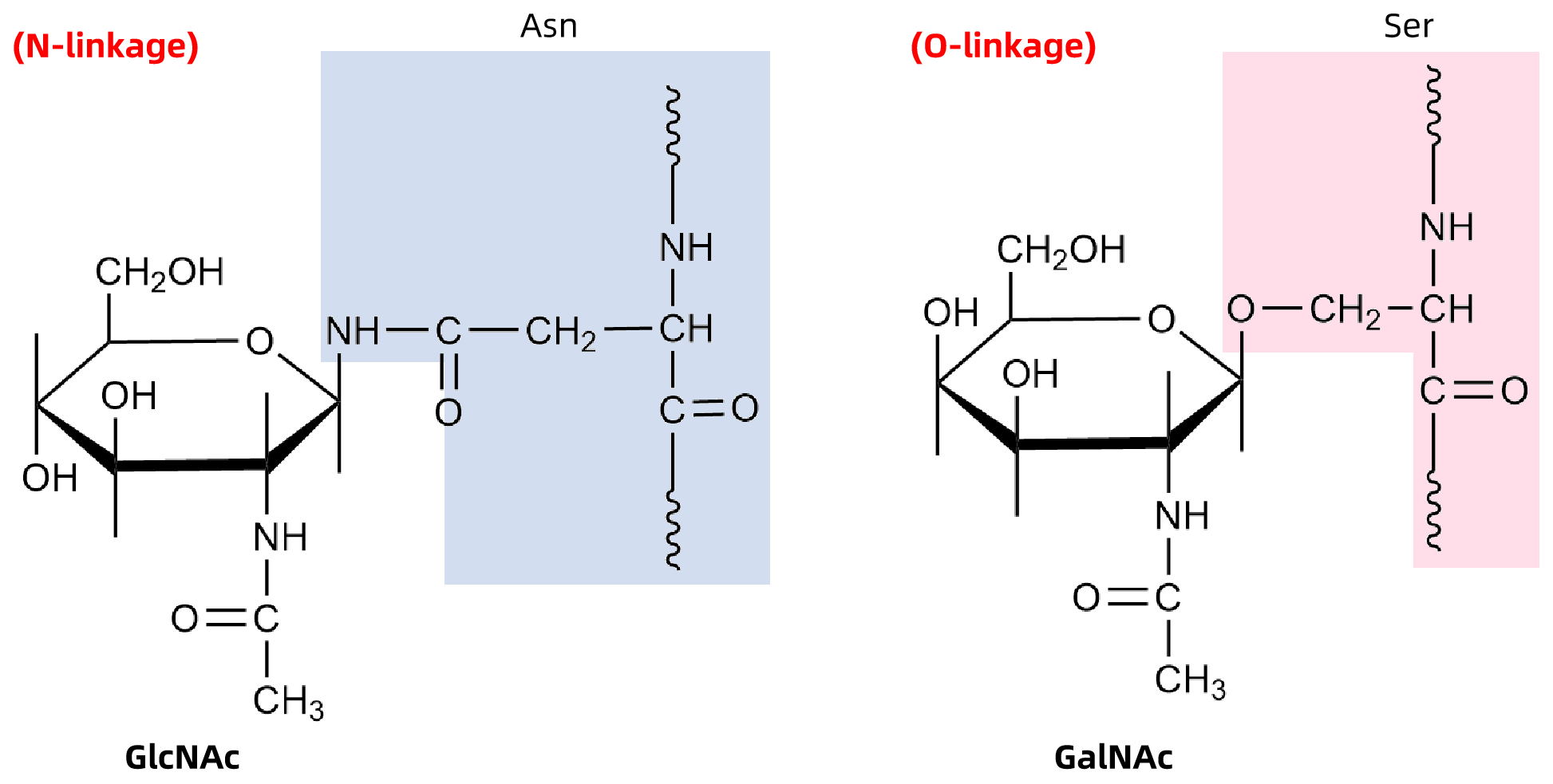O-Glycan Liberation Service
O-glycans are complex carbohydrate structures covalently attached to the serine (Ser) or threonine (Thr) residues of glycoproteins via O-glycosidic linkages. These glycans play vital biological roles in processes such as cell recognition, signal transduction, immune regulation, and disease progression. Unlike N-glycans with relatively conserved core structures, O-glycans lack a universal core and do not share a standardized release mechanism, posing unique technical challenges for their liberation and structural analysis.

Figure 1. Comparison of N- and O-Glycan Linkages
O-glycan release is a critical preparatory step in glycomics research, enabling in-depth analysis of O-glycan composition and architecture. This analysis provides a foundation for understanding disease-associated glycosylation patterns, identifying novel biomarkers, and advancing functional glycomics. MtoZ Biolabs offers O-Glycan Liberation Service utilizing a range of separation techniques to effectively release O-glycans from glycoproteins. Combined with our high resolution mass spectrometry platforms including Thermo Fisher’s Q Exactive HF and Orbitrap Fusion Lumos systems and nano-LC technology, we provide high sensitivity and high resolution detection of a broad variety of O-glycan structures, supporting both basic research and biopharmaceutical development.
Services at MtoZ Biolabs
MtoZ Biolabs offers O-Glycan Liberation Service employing both enzymatic and chemical release strategies tailored to the properties of each glycoprotein sample, ensuring optimal release efficiency and glycan integrity.
· Enzymatic Strategies
While PNGase F is primarily used for N-glycan release, it can aid in exposing nearby O-glycan structures under certain conformational contexts. Additional enzymes, such as O-glycosidase and Endo-α-N-acetylgalactosaminidase, are applied when working with well-defined or high-purity glycoproteins.
· Chemical Strategies – β-Elimination
This widely used approach cleaves O-glycosidic bonds under alkaline conditions using reagents such as NaOH and NaBH₄, which simultaneously reduce the glycan’s terminal groups to improve stability. This method is broadly applicable across glycoprotein types but requires precise control to minimize side reactions.
· Chemical Strategies – Hydrazinolysis
This method uses anhydrous hydrazine to break O-glycosidic linkages, providing high-efficiency glycan release while preserving native structures. It is particularly suited for structural studies requiring maximal glycan integrity.
Our experts will select or combine these methods based on sample properties and experimental objectives to ensure high coverage and accurate representation of O-glycan structures.
Analysis Workflow
To ensure accurate O-glycan release and reliable downstream analysis, MtoZ Biolabs follows a fully standardized experimental pipeline:
1. Project Assessment & Method Selection
Sample background and target information are reviewed to determine the most appropriate release strategy.
2. Sample Preparation
Includes sialic acid removal, desalting, dephosphorylation, or desulfation as needed.
3. Glycan Release Reaction
O-glycans are released using enzymatic digestion, β-elimination, or hydrazinolysis depending on sample requirements.
4. Glycan Purification & Derivatization
Glycans are purified using solid-phase extraction or magnetic beads. Optional fluorescent or isotopic labeling can be applied.
5. High-Resolution Mass Spectrometry Analysis
LC-MS/MS is performed for structural and quantitative glycan profiling.
6. Data Processing & Report Delivery
Includes qualitative and quantitative results, structural predictions, and spectrum interpretation.

Safferthal, M. et al. ACS Meas. Sci. Au. 2024.
Figure 2. O-Glycan Release and Analysis Workflow
Why Choose MtoZ Biolabs?
✅ Diverse Release Strategies: We provide a flexible combination of enzymatic, β-elimination, and hydrazinolysis methods to accommodate common and rare O-glycan types.
✅ High-Sensitivity Detection Platforms: Equipped with Orbitrap Fusion Lumos and MALDI-TOF MS, we achieve detection sensitivity down to the sub-picomole level.
✅ Comprehensive Structural Interpretation: We support O-glycan structural elucidation, branching pattern analysis, and isomer differentiation with database-assisted tools.
✅ Flexible Integration with Other Services: Easily combine with O-glycan enrichment, glycopeptide analysis, and glycoprotein identification services for expanded insights.
✅ One-Time-Charge: Our pricing is transparent, no hidden fees or additional costs.
Sample Submission Suggestions
We accept a wide range of biological materials for O-Glycan Liberation Service. Recommended sample amounts are as follows:
|
Sample Type |
Recommended Amount |
|
Cell samples |
≥1 × 10⁷ cells |
|
Tissue samples |
≥50 mg |
|
Biofluids (serum, plasma) |
≥500 µL |
For other sample types or limited material, please contact us for tailored submission instructions.
At MtoZ Biolabs, we deliver high-quality, systematized O-Glycan Liberation and Profiling solutions tailored to your research goals. Whether you’re decoding disease-related glycosylation or advancing therapeutic glycoprotein development, our expert team and cutting-edge platforms are here to support your success. Contact us today for customized consulting and service options.
FAQ
Q1: Will O-glycan release affect the protein structure?
Chemical release methods cleave the glycan-protein linkage and may disrupt the protein backbone, while enzymatic methods are gentler. We optimize buffer systems and release strategies to protect sample integrity as much as possible.
Q2: Can the released glycans be used for quantitative analysis?
Yes. We offer fluorescent and isotopic labeling options for released glycans, enabling both relative and absolute quantitation via our sensitive mass spectrometry platforms.
Related Services
How to order?







